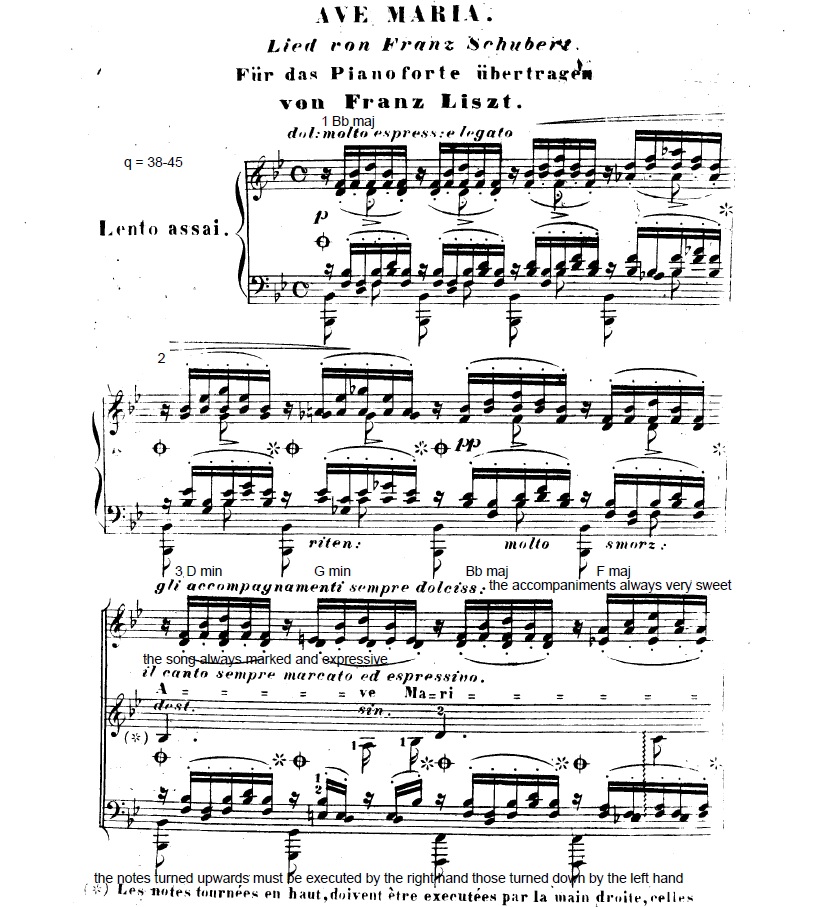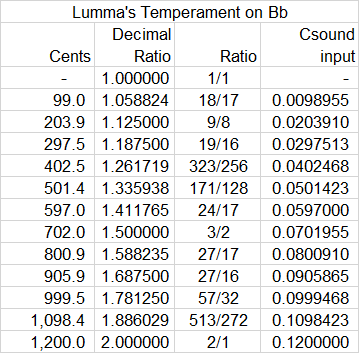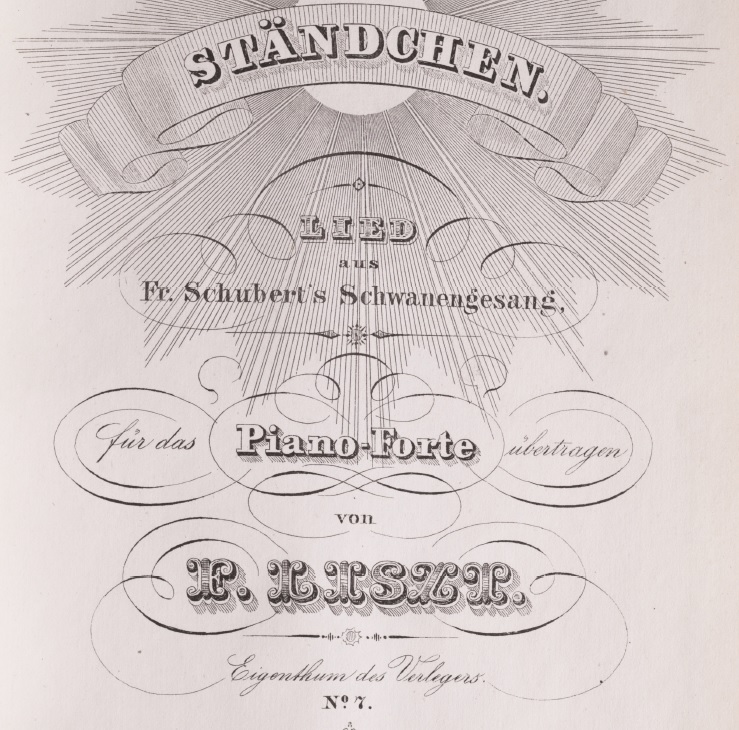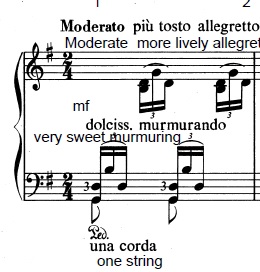Here’s a potential variation on the Rzewski theme. This one explores the 9:8 utonality that I used for the first few measures, with some glides and vibrato on Prent’s Microtonal Slide Bosendorfer.
Stream online:
or download here:
People #5

Here’s a potential variation on the Rzewski theme. This one explores the 9:8 utonality that I used for the first few measures, with some glides and vibrato on Prent’s Microtonal Slide Bosendorfer.
Stream online:
or download here:
People #5


This is the fourth try at a tuning that sounds reasonable. I’m using the same two utonal and three otonal 16 note scales as the source for the notes. I start at with the 9:8 utonality, which has a very nice D minor and A minor modes. In measure 6 I shift to the 5:4 utonality to play a sweet G minor and A major, the D minor and F major modes. Each is unique and charming, to my ears.
Rzewski used this theme as the vehicle for 36 variations that explored the range of pianistic techniques that he was so famous for. It’s really a wonderful piece. I don’t plan to transcribe his variations at this point. I may come back to variation 13, my favorite. My intention is to explore the tuning in different ways. I’ve been playing along on my little Midi keyboard in the various tuning, and have found some delightful keys that I plan to explore. And I can transpose the tunings in interesting ways as well.
I made a few changes to the tuning. It’s still very rough. This will take some time.
Basically, I use the following five 16-note scales which are either otonal (overtone based) or utonal (undertone based).
The 16-note utonal scales four “minor”, one neutral but close to major, and one major scales. The otonal scales can create 3 major and three “minor” scales. From all those scales I pull the tones I need to make each measure as consonant as I can.
Stream online:
or download here:
The People United Can Never Be Defeated – Frederic Rzewski #2

This is a version of the first movement of the Rzewski piece with some altered tuning based some otonal and utonal scales derived from the tonality diamond to the 31 limit. I’m not happy with some of the tuning and will continue to work on some different chords.
The piece is a set of 36 variations for virtuoso piano on the Chilean song “¡El pueblo unido jamás será vencido!” by Sergio Ortega and Quilapayún, which was popular in the 60’s and 70’s in Chile. Rzewski wrote his variations in 1975 as a protest against the repressive regime of Augusto Pinochet. Some say the U.S. had a major role in the coup that lead to Pinochet’s rule, which lasted from the 70’s into the 90’s.
The first movement is just a statement of the theme. I like the romantic harmonies, which sound ironic in a protest song. I hope to take the tuning into interesting areas as I continue to learn the piece.
Stream online:
or download here:
The People United Can Never Be Defeated – Frederic Rzewski #1

Here’s the first six measures of a recomposition of Lizst’s recomposition of Schubert’s Ave Maria. In this one I’ve stretched the tuning with some high number ratios. Not very far at this point, but that’s the direction. I also play with the thumb melody. In the Lizst version, the vocal part is played by the thumbs, between the high and low arpeggios. In this recomposition, they can go anywhere, and slide into place, or trill and slide simultaneously, or tremelo. More to come.
Stream online:
or download here:
Fantasy on Ave Maria #5

This is a realization of Ave Maria by Schubert, as re-composed by Franz Liszt. It’s a very familiar tune; it is often performed as Schubert wrote it, for tenor and piano. Liszt decided that he could play it all by himself. It’s devilishly difficult, as you have to play the melody with alternating thumbs of each hand, while playing thick chords and arpeggios above and below. It’s also a challenge to transcribe for Csound, since each measure contains up to 100 different notes. One measure (3:20 into the piece) took me an hour and a half, with most requiring at least 30 minutes. That compares to Standchen, which I could transcribe each measure in about five minutes.
The tuning is Carl Lumma’s VRWT temperament transposed to B flat.

The piece is realized using Csound on Prent’s Microtonal Slide Bosendorfer.
Stream online:
or download here:
Ave Maria #2

This is a realization of Standchen by Schubert. It is song number 4 from his Schwanengesang lieder cycle, composed in 1828 and published in 1829 just a few months after the composer’s death on 19 November 1828. The song is a setting of a poem by Ludwig Rellstab, “Leise flehen meine Lieder”, in which the singer exhorts his lover to make him happy.
Lizst recomposed the song into solo piano around 1839.
The tuning uses some otonal and utonal scales from the tonality diamond to the 31 limit.
The piece is realized using Csound on Prent’s Microtonal Slide Bosendorfer.
Stream online:
or download here:
Standchen #1

I spent some time with the tempi. I slowed down the parts that call for “un poco riten.”, which means to suddenly hold back the tempo. I changed the tempo for those indications to a quarter note = 55, and sped up the rest of the piece to q=70. There are lots of gradual tempo decreases, where he calls for “poco rallentando”, slowing down. I saved the really slow parts for the “riten.” and “smorz.”, which roughly translate to suddenly slowing down and dying away.
Stream online:
or download here:
Das wohin #7
For this version I made only a few subtle changes in the volumes of the five different loudness levels. Basically, I reduced the difference between the volume of the first note in a measure and the rest of the music. This reduced the kind of march-like quality that the first version had. This one has the same tuning as the previous version here.

When the measures are assembled, the appropriate &vol*. value is called.

Here, in measure #1, it’s all non-melody parts. Musical theorists have said that this intro is simulating a babbling brook. Ok.

Stream online:
or download here:
Das wohin #4
Here’s another one of Liszt’s recomposition of a song from Schubert’s Die schöne Müllerin. This one, in English, is called “Where To?”. The text is from a set of poems by Johann Ludwig Wilhelm Müller, about a wanderer who comes upon a brook and ends up in love with the miller’s daughter. She eventually spurns him because of his lower class.
In this recomposition, Liszt adds lots of arpeggios, but keeps the basic Schubert accompaniment to the vocal line.
This realization uses the otonality with a root of 32/21, a very sharp G major scale. Of the 16 notes in the 31-limit otonality, I chose the 12 that map well to the notes in the score. There are a few rough spots, but it is really amazing how one can chose 12 notes out of a 16 note scale derived from a 31-limit otonality or utonality, and come out with something that someone in Schubert’s time could recognize.
I couldn’t resist jazzing up the ending with a little stream sounds and some Tory Peterson recorded bird calls, including the Townsend Solitaire, White Throated Sparrow, and Hermit Thrush.
Stream online:
or download here:
Das wohin #1